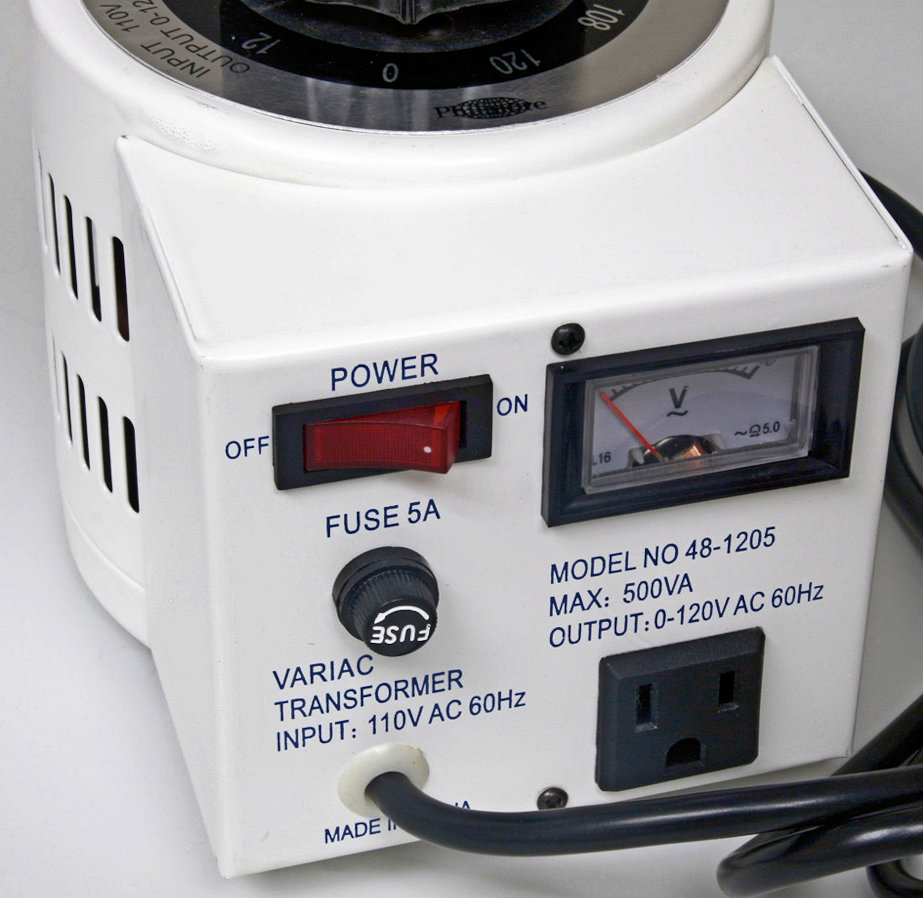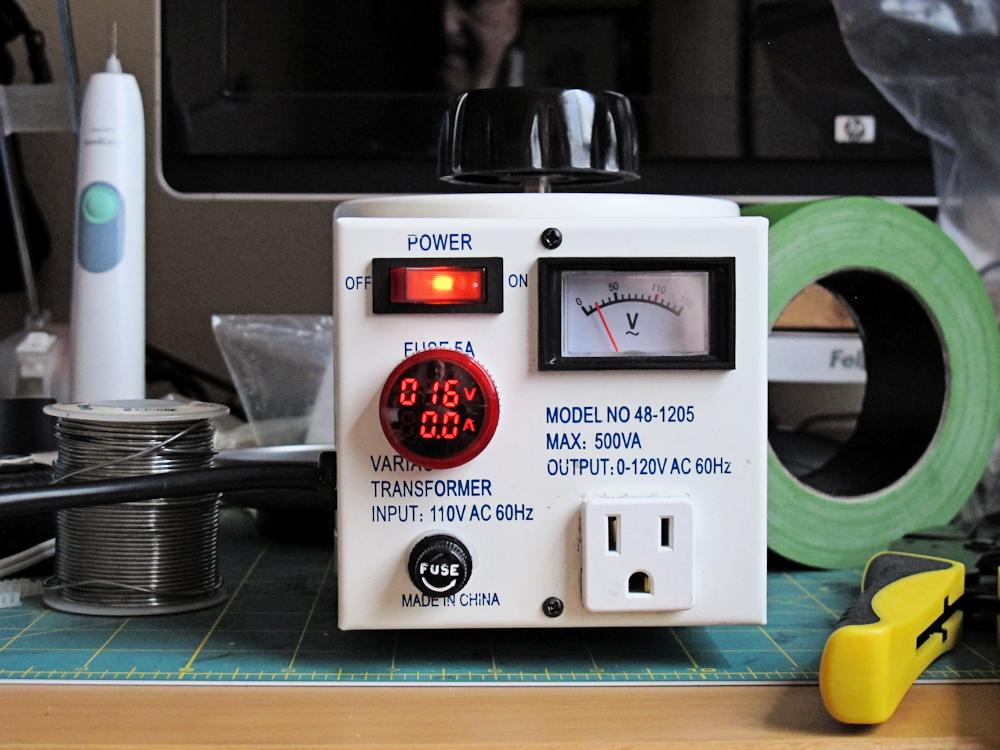It seemed like such a good idea at the time.
I’ve wanted an autotransformer for electronic troubleshooting work for a while. Autotransformers are variable transformers that let you bring the AC voltage up slowly on a piece of gear under test. I owned a Radio Shack/Micronta variable transformer for decades, but it didn’t survive my move to California during the dot-com boom and subsequent bust. I’ve waited nearly 20 years to replace it. Recently, I happened to see an inexpensive autotransformer in the Cogwell eBay store. Cogwell is a local used-equipment dealer that I frequent when I feel the need to satisfy a craving for equipment. The Cogwell online store offered a 500VA Philmore 48-1205 autotransformer for $35. Many dealers sell new copies for $70 or more.
I clicked away the 3.5 Alexander Hamiltons and hopped into my car to pick up my prize. Autotransformers are made of solid iron. They’re heavy suckers and therefore cost a lot to ship, so local pickup of such heavy items saves me almost enough to buy another piece of used test gear in the future. Sweet.
Cogwell’s modest offices are in a small industrial park that sits directly across Mission College Boulevard from Intel’s towering intergalactic HQ in Santa Clara. Interesting contrast. When I picked the Philmore up at Cogwell, I could see that the autotransformer really was brand new in the box. (See Figure 1.)

Figure 1: The stock Philmore autotransformer seemed to beg for some upgrades. (Image credit: Steve Leibson)
It worked fine when I got it home, so I really can’t tell you why I soon started thinking about modifying it. We have plenty of tuner cars here in Silicon Valley, but tuner autotransformers?
I blame Brad the Guitologist.
Brad Linzy, aka “The Guitologist,” fixes guitars and guitar amps, shoots videos about his work for his YouTube channel, and lives in Louisville, Kentucky. That’s where I was born and grew up, so I spend a lot of time watching Brad as he discusses and repairs vintage, tube-based guitar amplifiers. I don’t really care about guitars or guitar amps, but watching Brad describe, troubleshoot, and fix old tube amplifiers fascinates me. I must admit that I love listening to his authentic, Louisville drawl. (Officially, there are only two syllables in the name of my home town: “Lou” and “Vull.” Brad gets it right, of course.)
Brad the Guitologist works on some really crusty gear. Most of the guitar amps that he repairs were manufactured in the 1950s or 1960s. They’re so old that the electrolytic capacitors are usually suspect. Even some of the non-electrolytic capacitors, particularly the infamous Sprague Bumblebees, have gone bad. I’d never heard of Bumblebees before watching Brad. Apparently, they’re legendary amongst audiophiles and musicians.
Avoiding Electrolytic Detonations
Working with tube-based gear means that Brad the Guitologist really needs an autotransformer to bring these relics up slowly so as not to overexcite their decrepit capacitors and cause them to detonate. Old electrolytics relish the chance to explode when suddenly energized after years or decades of slumber. It’s almost like they lie dormant for years, dreaming of going out with a final bang.
Does Brad the Guitologist use a brand-name Variac autotransformer? Gosh no. He has a Philmore on his crowded bench. Brad has grafted a digital meter on top of his Philmore that displays output voltage, current, and power. I wanted that and I wanted to go Brad one better. I wanted a more factory stock look.
Perusing eBay, I found a slick, compact panel meter with dual displays showing AC volts and amps. It senses current using an inductive core attached by a two-wire cable to the meter. The whole kit including the inductive sensor cost $4.05, postpaid from China. (How do they do that? Just stay tuned, gentle reader.)
Because I was planning on doing some surgery inside of the Philmore anyway, I decided to add some connectors so that I could easily remove the front panel. The Philmore is designed in two pieces, both sheathed in steel. The rear cylindrical piece contains the big autotransformer. A big adjusting knob to set the autotransformer’s output voltage sits on top of the cylinder. The front part of the unit is a rectangular steel box that bolts to the front of the cylinder using two very long, black M2.5 screws. The box contains the power cord, illuminated power switch, a teeny tiny fuse holder, a 3-pin socket for the output power, and a small analog meter that displays the output voltage. The two halves, the cylinder and the box, are electrically joined by just three wires, soldered to both parts during final assembly. The three wires connect to the autotransformer’s high side, low side, and wiper.
This autotransformer is designed for low manufacturing cost, not easy servicing, so I decided that adding connectors between the two halves would make my upgrades easier to add. I bought connectors at a local electronics store to connect the three wires that run between the autotransformer and the front panel. As it turns out, I bought them three times, at three local stores.
One, Two, Three Times a Connector
The first time, I bought a 4-pin mating connector set from Anchor Electronics, one of the very few remaining surplus electronics outlets left here in Silicon Valley. However, I didn’t care for that connector. It didn’t look beefy enough, so I next went to Fry’s (a local electronics chain with a long Silicon Valley history) and bought a set of pre-crimped, 4-pin connectors commonly known as AMP Mate-N-Lok connectors). These common connectors were used to carry power to 5.25-inch floppy and hard drives in the 1970s and 1980s.
The connectors that I bought at Fry’s were a big disappointment. They didn’t mate well at all. The pins had been crimped poorly and the connectors were too large for the dwindling volume inside of the Philmore, so I returned to Anchor Electronics and bought four single-pin connector sets in a couple of plastic baggies. They cost a buck per bag.
When I returned home, opened the baggies, and took out the connector shells, I got a shock. I recognized these single-pin connectors! They were an obsolete Molex design. The last time I’d used these particular connectors was in 1970. I’d drilled them out and repurposed them as fiber optic connectors for the Dupont Crofon plastic optical fiber cable I bought from Poly Paks. I’d done this for a science fair project when I was a senior in high school. The project was a digital communications system that used RTL (which was the abbreviation for “Resistor-Transistor Logic” back then, not today’s “Register Transfer Level”), infrared LEDs, phototransistors, and plastic fiber optics in a crude parallel-to-serial-to-parallel communications system. That was 49 years ago!
The small analog voltmeter in the Philmore autotransformer is serviceable, but its resolution is just 5 volts per division. I’m not sure why I felt that I needed more resolution for the autotransformer’s output voltage, but I suspect the culprit was more gear lust, spurred by yet another YouTuber named Shahriar Shahramian, who creates videos for his YouTube channel called “The Signal Path.” Shahramian tears down and fixes high-end gear, mostly microwave and RF test equipment, for fun. Shahramanian’s day job is “Department Head, millimeter-Wave ASIC Research – Bell Laboratories,” per his LinkedIn profile.
As I’ve watched Shahramian’s videos on his YouTube channel over the last couple of years, a wall of test gear has grown on his bench in the background as he purchases, diagnoses, and fixes broken test gear on camera. He uses the repaired test gear to fix even more gear in a virtuous cycle. Shahramian’s test menagerie includes a repaired Sencore PR570 isolated variable transformer, which combines an isolation transformer with an autotransformer. The Sencore has digital voltage and current meters. I wanted that for my budget Philmore transformer. Obviously, I needed capabilities to rival Shahramian. (Not really. I don’t regularly fix network analyzers, spectrum analyzers, and other exotic microwave gear.)
Gradually, over nearly three months, I collected parts for my project. I noticed that the Philmore’s original three-pin outlet looked sketchy, so I ordered a name-brand Leviton AC outlet from Amazon Prime. It looked like a drop-in replacement. (It wasn’t, but more on that later.)
Eventually, my Chinese panel meter arrived in the mail. I needed to drill a 22mm hole in the Philmore’s front panel to accommodate the digital meter, but instead decided to enlarge the existing hole currently occupied by the fuse holder to accept the panel meter. A 22mm drill bit is rather large. It’s larger and more exotic than what I had in my tool crib, so it was off to visit Harbor Freight to purchase a step drill. Some YouTubers call these “Christmas tree” drill bits because they look like little golden Christmas trees.
Hot Glue Versus Strain Relief
I planned to move the Philmore’s fuse holder down to the front-panel hole currently used by the power cord, and then I’d move the power cord to a new hole in the side of the Philmore’s rectangular section. I needed to move the power cord because the Philmore’s front panel was getting too crowded with the added panel meter. In addition, I planned to put an actual strain relief on the power cord instead of the original rubber grommet (shown in Figure 1) retained inside with a small pool of hot glue. Hot-glued power cords don’t fill me with confidence for some reason.
After months of preparation and my various in-store and online purchases, I was ready for the surgery. The first step was to install the Molex connectors. I crimped the pins, ruining only one with my crimp tool in the process. Fortunately, I’d bought four so I had a spare. These connectors worked great for my purposes. They might have been my third choice, and they might be half a century old, but they were a good choice.
Next, I removed the fuse holder and power cord and then taped off the rest of the electronics to protect the rocker switch and the analog panel meter from flying metal shards as I enlarged the existing holes with the Christmas-tree bit and drilled the new one in the side for the power cord. I’d had to pry quite a bit of hot glue from around the fuse holder and power cord with a knife and a screwdriver. Whoever assembled my transformer, they really didn’t want any parts shaking loose and were liberal with the hot glue. Although the step drill required some cutting oil and a little effort to get through the steel front panel, I eventually got the holes I wanted and drew blood only once, when a steel shard took a liking to the tip of my left index finger.
I decided not to replace the Philmore’s 3-pin power outlet. It, too, was submerged in a pool of hardened hot glue, and I really didn’t want to pry it loose unless it was absolutely necessary. That glue is sticky and tenacious. The Leviton socket would have to wait to be used. As it happens, it didn’t wait long.
The inductive sensor for the digital ammeter from China just fit into the available space between the Philmore’s original 3-wire outlet and the analog meter, so I hot-glued it in place. It wasn’t going anywhere. Ever. As I added the connectors and the digital panel meter, I started to run out of room. The available volume in the rectangular box was deceptively small. It looks big from the front and sides, but half of the perceived volume is missing because the rectangular volume has a large cylindrical chunk missing from its rear to fit snugly against the round wall of the cylindrical transformer housing.
No Smoke. No Sparks. No Power.
Finally, I got the transformer buttoned up and switched it on. No smoke. No sparks. The illuminated power switch lit. The panel meter was dark, but the autotransformer’s output voltage was set to zero, so the meter wasn’t getting power yet. So far, so good.
As I slowly turned the voltage up from zero, the analog meter needle climbed and the new digital voltmeter lit up and started displaying the output voltage at about 16 volts or so. The ammeter read zero but I didn’t think anything about it because there was no load plugged in. This looked like it was going to be a winner.
Pardon my hubris.
My next step was to try to get the ammeter to read something other than zero. To do that, I needed to plug in a load. I tried a handy electric toothbrush charger on my bench. No reading. I guessed the load was too small. The ammeter only reads down to 100 mA. So I grabbed a 100-watt table lamp and plugged it into the Philmore. The ammeter still read zero but now there was a new wrinkle: the table lamp didn’t light. However, the newly installed voltmeter read 124 volts on the Philmore’s AC outlet, so I “knew” the transformer was delivering power.
A little work with a handheld voltmeter and I discovered that the Philmore’s 3-pin power outlet, the one that had looked sketchy to me, was sketchy. It had worked fine before my soldering work to install the new digital voltmeter, but the heat of soldering apparently had sufficiently melted the plastic connector shell surrounding the socket’s electrical blades, enough to disable the outlet socket. Time to install the Leviton.
That meant I had to unsolder everything I’d done, and then hack away at the hot glue pool surrounding the outlet socket. I finally got the AC socket free after clipping its wings (restraining tabs) with a pair of diagonal cutters. The cruciform-shaped hole that remained was too small for the Leviton replacement socket. A little metal hacking with a nibbling tool and the new socket fit nicely. (Coincidentally, that nibbling tool also dates back to my 1970 science fair project.)
I hot-glued the Leviton outlet socket in place and then attempted to resolder everything together. However, the Leviton AC socket had crimped wires – really heavy wires – instead of solder terminals like the original outlet socket. These heavy wires needed even more room inside of the rectangular box, and I needed a new wiring scheme.
I decided to dig a terminal strip out of my parts stash. I’d bought a bag of five strips from Radio Shack when its stores all went belly up in 2017. It was a 5-terminal strip, and it was just slightly too big to fit into the rapidly disappearing volume inside of the Philmore’s rectangular front-panel box. (See “The Radio Shack at the End of the Universe” for more information about Radio Shack’s closed stores.)
Point-to-point wiring using terminal strips is real legacy work, but it’s something that Brad the Guitologist does all the time on his YouTube channel as he repairs vintage guitar amplifiers that predate printed-circuit boards. A little Googling suggested that it’s become fairly difficult to buy just the right kind of terminal strip today if you need one quickly.
Choices are somewhat limited. No Amazon Prime to the rescue. These electronic components, like so many others, now need to come directly from China. Becoming impatient at this point, I clipped two of the five terminals from the Radio Shack terminal strip, folded over a third terminal that was attached to the strip’s mounting lug, mounted the strip to the back of the Leviton socket with a conveniently placed grounding screw, and was ready to solder everything back together.
One Last Trip
However, I first had to make a quick trip to Excess Solutions, another local electronics surplus store just south of downtown San Jose, to pick up some crimp lugs, because the Leviton socket’s heavy wires wouldn’t fit into the holes on the terminal strip. Excess Solutions somewhat resembles the warehouse used to store the Ark of the Covenant at the end of the first Indiana Jones movie. It’s a vast, dark cavern filled with row after row of metal shelves holding millions of electronic parts made over the past half century, all covered with fine layers of dust.
Excess Solutions’ prices are great. I spent $2.25 on parts, including an ample supply of crimp pins and some nylon edging for the reassembly, plus $3 for six new 2300 mAh NiMH AA batteries. The batteries are for a future repair project.
Finally, I returned home and soldered everything back together. The crimp pins from Excess Solutions were so crusty and corroded that they didn’t solder well even with extra flux from a flux pen. Next time, I’ll know enough to sand them down a bit before trying to solder to them.
At the second moment of truth, everything came up just fine except for the ammeter. No sparks. No smoke. This time, there was power in the outlet socket. However, the ammeter still read zero. At least the patient lived. I hadn’t killed it. The external result appears in Figure 2.

Figure 2. Compare the appearance of the modified Philmore autotransformer with the stock image on the box in Figure 1 to see the external modifications I made. (Image credit: Steve Leibson)
As a hobby project, this weeks-long effort provided ample diversion. I’ve got a much-improved $35 autotransformer, after spending at least double that amount for upgrade parts and new tools. As a practical matter, I wouldn’t recommend taking this path to anyone else. Buy a used, working Sencore if that’s what you really want. It’ll be cheaper and faster.
One last thing I do recommend: test any electronic components that you get from China before securely hot-gluing them into a tight spot. Believe me, that’s the voice of experience talking. I just heard from the vendor in China. They’ve graciously offered to mail another panel meter to me. When it arrives, I’ll test it before installing it. I’ll let you know what happens.





